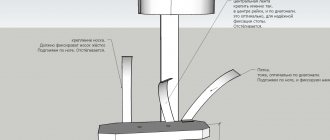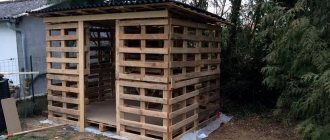Today you can count more than a dozen different types and designs of stone ovens for cooking, but the Pompeian oven occupies a special place among them.
Pompeii oven
Compact, efficient and beautiful - it will not only allow you to cook delicious food, but will also look stylish on any country plot. How to lay out a Pompeian oven with your own hands, and what technical nuances should be taken into account, we will discuss in this article.
A standard Pompeii stove is characterized by certain proportions that must be observed regardless of the shape and size of the structure. Thus, the height of the entrance is approximately equal to 50% of the total height of the dome. This allows you to optimize the work process as much as possible, create normal traction and reduce heat losses.
Financial and economic aspect of building a Pompeian oven with your own hands
What is the reason for the relatively high price of such a stove?
- The Pompeian stove is made of fireclay bricks, which cost an order of magnitude more than usual.
- The design of the stove is quite heavy, and for ease of use it must be raised to a height of 80-100 cm. To do this, you will have to lay out a brick stand on which the stove itself will be built, which means you need to think about a good foundation.
To slightly reduce the cost of building a stove, any materials available on the farm are suitable for the stand: blocks, ceilings, old bricks, etc.
Building a pizza oven
Another disadvantage is the lengthy process of laying a Pompeian stove. A rather complex design, which requires the presence of a foundation, a pedestal, the stove itself, and a large countertop, indicates that the whole process will take at least a month.
In addition, you will need significant technological breaks to harden the concrete for the foundation, etc.
If you come to the dacha only for the weekend, then the entire masonry process can be rationally distributed into several stages, calculating that the technological break for “setting” the materials occurs during your absence.
Traditionally, the Pompeian oven has the following layout:
- solid foundation;
- pedestal for the stove;
- bake.
Pompeian pizza oven
The oven itself, in turn, consists of four parts:
- base (furnace bottom);
- dome (vault);
- entrance arch;
- chimney.
The base (pedestal) is made of small cinder blocks, 20*20*40 cm each.
The tabletop is a monolithic slab made of reinforced concrete 10 cm thick.
Tabletop
Unlike a traditional stone stove, here the chimney is located at the front. This determines one of the main differences in the design. The fire rises up along the dome, heating the vault. Thanks to this, heating is carried out simultaneously from above and below, which contributes to fast cooking.
The Pompeian stove has undergone many changes over the many years of its existence, and today you can find several of its varieties.
Neapolitan oven
There are Tuscan and Neapolitan ovens. The Tuscan stove has a higher arch and is more versatile in use. You can bake not only pies in it, but also cook stews, meat, and soups.
The Neapolitan oven is traditionally used for baking pizza and has a small dome that is approximately 80% of the total dome height.
Tuscan oven with a higher arch
As for the shape and size of the stove, the most optimal design is the one with an internal diameter of 80-110 cm. It is not recommended to make the stove smaller than this.
The spherical arch of the oven serves for maximum heating and heat accumulation, and the arched entrance is used for storing firewood and the food itself.
The size of the oven may vary, but in any case, strict proportions should be adhered to: the height of the arch should be approximately equal to 60% of the total height of the dome.
The width of the entrance for storing firewood should be equal to the total height of the dome.
Multilayer dome of a Pompeii oven
The vault itself has several layers:
- the internal surface is made of fireclay bricks;
- clay coating;
- 1st layer of basalt wool (thermal insulating);
- 2nd layer of perlite;
- Facing layer made of cement mortar.
In this case, the thickness of each layer should be approximately the same size, 5-10 cm. The more heat-insulating layer is laid, the longer the oven will cool down.
The facing layer can be made from any moisture-proof and water-repellent materials, since its main purpose is protection from precipitation. If the stove is being baked in the house, then this protection can be omitted.
In addition, the facing layer also performs a decorative function, so you can make it to your taste: decorative plaster, painting, mosaic, etc.
Conclusion
In order to delight your household and your guests with delicious pizza, as well as pleasant gatherings near a warm fire, every enterprising owner can build a Pompeii pizza oven in his own garden with his own hands. This structure can be made of brick, and if you want to save money, it can be built from clay material. The main thing is that the entire system is manufactured in accordance with technology and basic rules.
What kind of Pompeian stove will you make?
From brick From clay
DIY assembly
The first step is to prepare a solid foundation. It is better to do this in the summer, when there is minimal rain. But precipitation cannot be completely excluded, so a waterproofing film will not be superfluous.
Markings are made at the location of the entire structure and a pit is dug. Its depth should not be less than 350 mm. A formwork made of wooden boards is assembled along the walls of the pit, which is then covered with plastic film. It will become the basis of the waterproofing cushion.
A small amount of medium-fraction crushed stone is poured on top of the polyethylene, and a layer of sand no more than 100 mm thick is added on top. All this is covered with film on top. The waterproofing pad is poured with prepared concrete.
As soon as the level of the solution reaches the edge of the formwork, reinforcement is made. After this, the foundation must be left alone for 3 weeks. During this time it will finally settle down.
Drawing of a Pompeii oven
Pedestal with table top
This oven element is easiest to assemble from cinder blocks. They are inexpensive and easy to process. The height of the pedestal is selected taking into account the height of the user. It should be sufficient for comfortable work. The minimum value is 800 mm.
The shape of this element should be U or H-shaped. With a side length of 1200 mm, there will be 3 cinder blocks on each side of the base.
Initially, the pedestal is assembled without using a solution. The blocks are connected to each other using wire. Then their position relative to the foundation is verified using a building level and other measuring instruments. If everything is in order, then cement mortar is poured into the holes of the blocks.
After three days you can assemble the tabletop. This work consists of the following stages:
- Assembly of formwork up to 150 mm high.
- Covering the bottom with waterproofing material.
- Assembly of a reinforced frame on waterproofing with a cell pitch of 50 mm.
- Pouring concrete into the formwork and leveling it.
Creating a dome
After the tabletop has hardened, markings under the dome need to be applied to its surface. The diameter of the circle must correspond to the selected project.
According to the markings, taking into account the order, the base is laid out. Fireclay bricks are used for it. This is the so-called hearth. At this stage you need to be extremely careful. The slightest mistake will lead to the ineffectiveness of the entire structure.
The hearth is laid out without the use of cement. This is necessary to identify bricks that will subsequently be cut.
Before the final installation of the hearth, the surface of the base is laid out with silicate tiles. When it is securely fixed, the treated brick is laid on top using mortar. Then you can begin building the dome.
This is useful: how to prepare mortar for laying bricks. The Pompeian stove will be an excellent decoration for the yard
It is recommended to carry out all work on the further construction of the furnace using cardboard templates. The laying of the dome begins from the entrance to its rear part. The distance between the bricks increases with each subsequent row. It needs to be fixed with wedges. Templates must be used until the dome is completely completed. To create an external arch, it is recommended to use a plywood template.
The creation of the Pompeian oven is completed by thermal insulation and plastering. Calcium silicate slabs are usually used as a thermal insulation layer, but if necessary, mineral wool can be used.
Clay or plaster is used for facing work. If there is no canopy over the stove, then double plastering is required.
Now the structure needs to be tested. During the first warm-up, it is allowed to use no more than 2 kg of fuel. It should be paper or straw. For the second start, you can use 500 g of brushwood. The third heating will require 4 kg of pellets. From the fourth kindling you can use ordinary firewood.
How to make a Pompeii oven with your own hands:
Option made from clay (without brick)
Making a Pompeii oven from clay, without using bricks, is a simple process. The foundation and tabletop are made in the same way as in the case of the classical design, but the model is made from coarse sand (screenings). A clay dome is laid on top of it.
Pompeii made of clay
Device
It is best to use special clay; you can purchase it at a construction warehouse. How to properly make an Italian design from clay is well shown in this video:
A Pompeii clay oven is installed with your own hands in the same order as when constructed from other materials. After the dome is installed, a chimney is made - any materials can be used for its construction, including ordinary brick.
Expert opinion
Nikolay Davydov
Stove maker with 15 years of experience
As in the case of a brick Pompeian stove, waterproofing and thermal insulation are required, which will ensure a long service life, as well as cladding, which will protect the structure from irritating factors (rain, hail, snow).
The Pompeii clay pizza oven is a simple design to construct - anyone can make one like this.
How does it work?
It is important to understand the furnace structure before moving on to the construction phase. The operating efficiency of the equipment depends on the technical features
Temperature changes in the oven are self-regulated due to cyclic changes in gases, which is a characteristic feature and is perfect for baking baked goods and pizza. The dome of the structure is one of the main elements in the organization of work, accumulating heat energy emanating from the fire. During the combustion of solid fuel, two gas flows interact in the dome cavity:
- The first is convection. The flow is directed from the firebox.
- The second is reflected. Gas streams reflected from the walls of the dome itself.
Design diagram
- Foundation.
- Pedestal.
- Tabletop.
- Entrance arch.
- Under.
- Dome.
- Smoke exhaust.
How to make a small fireplace with your own hands, step-by-step instructions
Photo 1. Detailed diagram of the Pompeian pizza oven with explanations and dimensions.
When laying the foundation, it should be taken into account that the furnace will weigh at least 700 kg. The base must be strong and level to ensure the durability of the entire structure.
The stove pedestal is a continuation of the foundation and raises the structure itself to a height of about 1 m.
The tabletop is a working area. It is placed on a pedestal and formed under the (bottom) of the oven chamber. The tray must be perfectly level, since the pizza is baked directly on it without any equipment.
Important! The hearth material must be safe in composition for cooking. An entrance arch and a stove dome are formed around the bottom in compliance with the proportions of the specific scheme
A rectangular hole is left at the top of the ceiling to connect the chimney
An entrance arch and a furnace dome are formed around the bottom in compliance with the proportions of the specific scheme. A rectangular hole is left at the top of the ceiling to connect the chimney.
Materials for building Italian stoves
The construction chamber is made of fireclay bricks. You can also take fireproof stone. Fireclay sand and clay are used for mortar; cement mixtures are not suitable.
Attention! To form the dome and hearth, the use of ordinary bricks is not allowed. Otherwise, the chamber will crack and the masonry will begin to collapse
The foundation is a reinforced concrete slab laid on a bed of sand and crushed stone.
To build a pedestal on the foundation, ordinary clay bricks or silicate blocks can be used. As a rule, the pedestal has a niche for storing firewood or dishes.
The countertop can also be made of brick and stone, but it is better if it is monolithic. To do this, use a ready-made slab or pour a mortar reinforced with reinforcement into the formwork yourself. The recommended tabletop thickness is 100 mm.
A layer of hydro- and thermal insulation is required between the bottom of the stove and its countertop to avoid heat loss and destruction. Separation is carried out using a calcium silicate pad, expanded clay filler or perlite sand.
The outer part of the oven also requires insulation, which consists of several layers:
- Heat-resistant plaster over brickwork.
- Basalt mineral wool.
- Decorative moisture-resistant finishing with a special mixture, stone, tile.
The chimney of a pizza oven is made of brick, metal, asbestos in the form of a pipe or box.
When constructing a furnace vault, hinged and radial spherical templates made of plywood, lumber and metal parts are used. Without stencils, the dome will not turn out semicircular.
Important! If the stove is planned to be installed outdoors, a canopy is required to protect the structure from precipitation
What is a Pompeian oven?
A Pompeian or Roman oven (Italian, dome, Neapolitan, etc.) is a culinary stone, wood-burning, dome-type oven, not intended for heating, used exclusively for cooking. Often used by pizzerias to bake pizza. Powered by wood. It has a dome, which provides the exceptional characteristics of this Italian stove. Allows you to prepare pizza, bread and other famous dishes. Italy is considered the birthplace of the Pompeian stove. In the Roman city of Pompeii, historians found a perfectly preserved oven, hence its name. This type of stove has been known to the world for about 3000 years.
Features of the Italian stove:
- The dome ensures rational distribution of thermal energy and its minimal losses. Because of this element, heat is not wasted and is retained inside the oven for a long time.
- The small dimensions allow the stove structure to be placed in a place convenient for the owner. The structure is mobile.
- Unlike the Russian stove, the Pompeian stove has an oval arch and is significantly lighter.
- Such stove structures have a lot of weight, which primarily determines the heat capacity and economic efficiency of the stove.
- It runs on wood and is not intended for space heating.
- Heats up quickly - in about 30-60 minutes the oven is fully ready for use.
Types of Pompeii ovens:
- Tuscan ovens are miniature in size. The dome is a regular hemisphere; the height of the dome is equal to the radius of the stove. The Tuscan type of oven is designed for baking pizza and other foods.
- Neapolitan stoves are also a special case of the Pompeian stove; the main difference is the lack of a clear geometric shape and parameters. Has a small dome. Since these types of ovens are often larger than the Tuscan design, they can cook pizza much faster.
Essential elements:
- Under is the place where firewood is placed.
- A vault is a hemisphere made of bricks.
- The firebox is the place where food is prepared.
- The chimney is built from baked solid bricks. It can be laid directly from bricks or from metal and ceramic blanks and pipes.
Device
The design of the Neapolitan stove is easy. Making a Pompeii stove yourself is not difficult. The components of this stove are:
- The base of the Pompeian furnace (foundation).
- A table that is necessary for comfortable cooking of any dish.
- A hemispherical vault or otherwise called a dome. Another component of the furnace is the under. Under (the bottom of the oven or its floor) is the place where the fire is lit and the pizza or other dish is cooked.
- The fourth part is the chimney pipe.
- Outer casing.
- Thermally insulated layer.
These are the main components of a Pompeian oven that do not require professional intervention for their construction.
Oven-pro
The stove described is good, but simplified. It's suitable for a picnic, but it's difficult to bake pizza after pizza in it all at once. In addition, a professional furnace must be larger, with a hearth working area diameter of 1 m. This leads to the following design features, see figure:
Construction of a professional pizza oven
- Effective thermal and waterproofing under the foundation with a distance of at least 1 m to the sides to prevent extraneous fumes from entering the furnace.
- Due to its large weight, the stove is built on trenches that transfer its weight to the base.
- To maintain the required temperature and circulation of gases in a large chamber, some air flow is required from behind, for which an air duct is provided.
- The dome is double with intermediate thermal insulation, for the same purpose.
- The chimney has a view, which regulates the draft depending on the type of fuel, outside temperature and, most importantly, the discretion of the chef.
Essential elements
Foundation. It is indispensable when constructing such a structure. Instead of such a base, a reinforced concrete slab can be used, which is laid on a gravel bed.
Stand. It sits on a bed of gravel, allowing you to raise the structure to a comfortable height, making cooking easier. The stand itself is a square box with brick or concrete walls.
Table. We are talking about a flat surface installed directly on the stand. In essence, this is reinforced concrete, the thickness of which is about 20 cm. Such an element must withstand the weight of the furnace and provide high-quality thermal insulation of the hearth.
More about mini ovens
The author of the article was once invited to a pizza picnic. But, as it turned out, there was no trace of a special oven there. The hostess and her friends were completely sure that the pizza was fried over coals in a frying pan. What should I do?
Among the dishes there were 3 glazed clay dishes, two identical large ones and one smaller one. I had to think twice and even point my finger at the calculator to determine when the pizza would arrive. Then the workpiece was placed on a smaller dish, it was placed in a larger one and covered with another. Meanwhile, the fire had burned down to coals, they were cleared away, a makeshift stove was placed on the fire and covered with coals.
Pizza pot oven
After the calculated time had elapsed (heating inside from 300 to 400 degrees for 5-6 minutes), the pizza was removed and eaten. It turned out so-so, it took a long time to warm up to 300 degrees. But it turned out to be a revelation for the ladies; they weren’t even offended and took note.
And after some time, the “inventor” was surprised to learn from them that a similar mini-pizza oven, it turns out, had been mass-produced by Earthfire in South Africa for a long time, see fig. It costs a lot on sale, about 2000 rubles, and requires fairly high culinary skills. However, it is completely energy independent and will come in very handy at a picnic with pizza.
First firing
Before lighting the stove for the first time, you must make sure that all materials are completely dry and the concrete or mortar has set. The longer you let the concrete dry, the stronger it becomes. You can wrap the structure in salophan or a damp cloth to prolong drying time.
During the first ignition, the water remaining in the masonry turns into steam, and can lead to cracks at this stage
For this reason, it is important to let the oven sit until it is completely dry. Heating of the oven itself must be done gradually
This also applies to brick and stone ovens. When starting the fire for the first time, you need to light a small fire and gradually increase the load of wood. Try not to use large firewood as this can cause the heat to build up quickly. The initial kindling should be spread over a 6 hour period. After you first fire up the fireplace, it should be carefully inspected for signs of cracks in weak points. In subsequent burns, you can use larger logs and heat the oven to its full potential.
Design features
According to historians, the first Pompeian ovens appeared in Italy and then spread throughout the Iberian Peninsula within a very short time. Initially, such structures were built for preparing simple food. They were not used for heating, since there was no need for home heating in those regions.
Later, this type of oven spread throughout the world. It is also known as a tandoor or Neapolitan oven. An important design feature of such a furnace is the presence of a dome that distributes heat throughout the entire internal volume. In addition, it significantly reduces heat loss and provides stable traction.
The Pompeian oven is small in size. Most often it is installed outdoors, since that is what it was originally created for.
You will need the help of a master when studying the drawings
The Neapolitan stove has certain similarities with the traditional Russian stove, but its heating efficiency is higher. It will take several hours to heat a Russian oven to the temperature required for cooking pies. In the Italian equivalent, you can start cooking them in just 30 minutes.
This efficiency is explained by the lower thermal mass. The thickness of its walls is only 12 cm. This allows them to warm up to a temperature of +370°C within 1 hour.
The temperature inside the Pompeian oven is self-regulating. This is achieved in an original way. As the maximum temperature values increase, the amount of gases in the combustion chamber increases significantly. As they rise, they actually block the access of oxygen from the mouth of the pipe. Because of this, the combustion intensity decreases, and then the temperature. The amount of gases decreases, and oxygen access to the firebox is restored.
This cycle is constantly repeated, which ensures that the temperature is optimal for cooking food.
How does the Pompeian stove work:
Principle of operation
The heating principle inside the Pompeian system is based on two hot air flows - convective from the hearth and reflected from the ceiling.
Expert opinion
Nikolay Davydov
Stove maker with 15 years of experience
Inside the oven, the temperature is regulated without human intervention. This is done due to the physical properties of the combustion products: if the firewood flares up strongly, the gas released by the fire when exiting the system presses the incoming air flow so that the intensity of firewood combustion decreases, and therefore the temperature in this unique design is normalized.
Principle of operation
An important role in the design is played by the dome, which emits heat flows, thereby heating the surface of the food, and consequently preparing its upper layers. That is why in these systems the pizza becomes perfectly cooked.
We build it ourselves
If we take a strict approach to the issue of baking pizza, then no factory equipment can give a truly “real” result. This means that lovers of Neapolitan or Diabola will have to build a pizza oven with their own hands.
Foundation
The total mass of the finished structure is quite large. Even installing any brick oven outdoors requires a solid foundation in the form of a foundation. Our Italian stove will rest on a solid reinforced foundation with a crushed stone cushion.
To dig a pit you need to know the dimensions of the future furnace. As with any other construction, you will need a drawing. The layout of the furnace is quite simple, so the drawing shows only the dimensions of the structure. The pit should have linear dimensions slightly larger than the dimensions of the furnace podium.
Good to know: Is it worth using a gas heater in the country, which model to choose
A pillow is installed at a depth of 40 cm. To do this, a layer of crushed stone is poured and compacted tightly. Then, the rest of the foundation is filled with mortar, for the preparation of which cement and sand are used. This is an ordinary solution with a ratio of 1 and 4, which fills the space limited by the formwork. A reinforcing mesh should be placed on the surface of the pillow and throughout the entire layer of mortar.
After raising the foundation to the desired level, you need to check the horizon and leave it for several days for the solution to dry completely. To ensure that moisture evaporates evenly over the entire depth and cracks do not form, the new foundation is covered with a film.
Stand and table top
It is too early to design the firebox, as it will be located low and inconvenient to work with. In addition, you can create a functional addition to the stove - a compartment for storing firewood. A stand will be formed on the surface of the foundation. It plays a load-bearing role and determines the height of the furnace. When building independently, the height is selected according to your height. The walls of the stand are formed of strong concrete blocks; there is no front wall. A kind of niche is formed for storing firewood.
Creating walls
The height of the table top is usually 10 cm. This layer of mortar should have two layers of reinforcing mesh. There is a gap of 5 cm between them. After pouring, the tabletop is covered with film and dries for several days. Now you have a base that can support a wood-burning pizza oven.
Walls and dome
To build any wood-burning stove, you need to stock up on refractory bricks. The inner surface of the firebox, where the highest temperature is observed, is lined with fireclay bricks. Clay mortar with good adhesion can be purchased at the store in the form of a dry mixture. Preparing the solution yourself will take a lot of time, since you will first have to select a type of clay suitable for its fat content, grind it and mix it with sand.
At the first stage, the arch of the vault is laid out. It is necessary to prepare a wooden template that will hold the arch until the solution hardens.
Creating an arch of the desired shape
After this, we begin the construction of the dome. A row of bricks is laid out around the circumference on the tabletop. To form a dome, many craftsmen advise making a wooden internal frame.
Appearance of the finished structure
But there is a more convenient and practical way. Sand is poured into the space limited by the first row of bricks. A pile of compacted sand is given the desired shape. It can be used to lay out the dome, and then the sand can be removed through the firebox inlet.
Creating a firebox shape using sand
The wood-burning pizza oven body is plastered with clay mortar. Clay can withstand temperature and will prevent heat from escaping from the firebox through possible cracks.
Good to know: Tiled stoves-fireplaces, a new wave of popularity of antique finishes
Chimney
The design of the chimney in a Pompeian stove is quite simple, but at the same time it has one feature. The pipe protrudes forward, towards the entrance to the firebox. Since the stove model is outdoor, there is no need to build a high channel. It is enough just to ensure that the smoke escapes outside.
Construction work has been completed
Having completed all stages of construction, the oven should be left for several days. Despite the fact that the solution dries quickly on the outside, moisture will remain throughout its entire depth for a long time.
The main cooking styles are:
Cooking in the oven
Roasting:
Pompeian brick oven heat of 350 degrees or higher is used to bake pizza, pizza-like flatbreads and some types of appetizers, all of which take just a couple of minutes to cook. The goal of this type of cooking is to completely fill the floor and dome with heat, create a large "bed" of coals, and maintain a large fire as the flames reach the top of the dome. There are two ways to tell when your oven is ready to bake your pizza. Firstly, when the oven dome itself has cleared up and there is no visible black soot. At this point you should move the heat to the side, continuing to keep the heat high as the flame reaches the middle of the oven. Alternatively, if you are using an infrared thermometer, the oven floor should be between 350-400 degrees. Pizzas are baked right on the floor next to the fire. Leave the oven fully open and add wood every 15-20 minutes to maintain a high flame.
Baking:
Bake (250 degrees and below) is used for baking breads, desserts, small cuts of roasted meats, beans and legumes, and pasta dishes at regular oven temperatures. After the Pompeii oven is fully fired, carefully remove the hot coals and clean the oven. Your Russian oven can now cook accurately and consistently with the heat stored in the oven dome and floor, maintaining a constant temperature for a long time. Using this type of cooking, you can bake either one full batch of bread, or several baths of different types of bread, but in smaller quantities. Close the oven door tightly to trap heat inside.
Roasting:
A Russian brick oven or Pompeian oven makes an excellent grill. By raking a layer of hot coals to the front of the oven and placing a rack in the oven, you can enjoy grilling gorgeous meats.
Also, try experimenting with different pots and pans. A grill pan preheated in the oven gives your cuts of meat a beautiful seared pattern, while a terra cotta plate and steel plate make fried potatoes taste completely different than deep frying.
If a Russian brick stove or a Pompeian brick stove was laid out for you by a good, competent stove maker, then such a stove will take a central place not only in everyday life, but also on those days when you have friends over. A skillful hostess will be able to offer something new and unforgettably delicious for every such meeting! Experiment! And we will build a good Russian stove!
What is a Pompeian oven?
Pizza oven – Pompeian
The Pompeii oven is a variant of the domed deck oven, the main purpose of which is baking pizza. You can also cook other dishes here: bread, flatbreads, pies. The design of the pompeika is close to the Russian stove, as it includes a large combustion chamber. The hole for loading products can be located on the side or on the top. The latter option resembles a tandoor, but the principle of operation of the pompeika is somewhat different.
The Pompeian stove is designed for cooking only. It is impossible to heat a house with it.
Design
The entire structure consists of 3 parts: a foundation, a pedestal 110–120 cm high, a table top and a stove. The latter includes the following components:
- under the floor go to the bottom of the stove;
- dome – regular semicircular or oval shape;
- entrance arch - usually on the side;
- chimney - located above the entrance to the stove.
The dimensions of the structure vary widely, but the proportions must be respected. The ratio is:
- the height of the entrance arch is 60% of the height of the dome;
- The width of the arch is equal to ½ the height of the arch.
Principle of operation
Since the oven consists of 1 row of bricks, it heats up quickly
The Pompeian stove heats up much faster: it is formed by only 1 row of bricks laid in a bed. After just 45 minutes the temperature reaches +250°C, and after another 15 +350°C. The bread here is baked in literally 15 minutes.
This efficiency is possible thanks to an unusual heat flow pattern:
- convection currents diverge from the combustion chamber;
- they are reflected from the walls of the arch and form reflected flows.
The filling is wood-burning and burns slowly until the volume of warm air becomes so large as to block the flow of air through the narrow mouth of the stove. At this moment, the combustion becomes weaker, and the temperature decreases slightly until the moment when oxygen cannot penetrate into the furnace again. The cycle is closed and repeats until the wood is completely burned.
Advantages and disadvantages
The Pompeii oven is a complex structure and requires experience to construct it
The Pompeian oven provides many advantages:
- quick heating - within half an hour, after which you can bake pizza;
- high heat accumulation - after complete combustion of a portion of fuel, the temperature is maintained for several more hours;
- compactness - Pompeika is small and quite beautiful.
Minuses:
- complexity of the design – the construction of such a model requires experience;
- heavy weight - a foundation is required for the pompeii;
- high cost - construction requires expensive fireclay and clay bricks;
- construction takes a lot of time.
Project selection
Taking into account the configuration of the dome, two types of Pompeian oven are distinguished. The first type is called Tuscan. Its dome height and radius have the same values. The Neapolitan dome has a height 20% less than the radius.
This oven is used for preparing various types of dishes.
The Tuscan stove is considered universal due to its higher arch. It perfectly cooks meat, stews, soups and pies. Neapolitan design has a narrow specialization. It is ideal for preparing various baked goods. Experts recommend choosing the Tuscan option.
As for the dimensions, the internal diameter of the oven should not be less than 110 cm. Otherwise, it will be inconvenient to cook in it.
A Tuscan oven can have different sizes, but its proportions must remain the same. For example, the height of the arch should be 60% of the dome, the width of the hole for storing fuel should also be calculated based on the total height of the structure.
The chimney should be placed at the front of the stove. This is especially important for our climatic conditions. After choosing a project and determining the location of the entire structure, you can begin purchasing materials and subsequent construction.
Features and characteristics of pizza ovens
Pizza is one of the most famous culinary dishes in the world.
Its history begins around the seventeenth century, at which time special chefs appeared who prepared culinary dishes for peasants in Italy. Subsequently, the dish received the status of the national dish of Italy.
Today in every city you can find several pizzerias that attract people with a wide variety of recipes with an incredibly wide range of all kinds of ingredients and toppings.
As a rule, the entire cooking process takes place in front of visitors, which has a positive effect on the process of waiting for a flavorful dish and encourages visitors to buy flavorful pizza. Therefore, furnaces are indispensable equipment.
A pizza oven is highly professional heating equipment used by Italian restaurants, pizzerias, and fast food outlets to prepare pizza.
Despite its narrowly targeted name, it is widely used for baking baked goods, frying eggs, and finishing semi-finished products.
A special feature of this type of equipment is a stone tray that accumulates heat and maintains a constant high temperature (up to +500°C) inside the chamber. The pizza preparation process takes place directly on this hearth, which takes no more than 7 minutes.
Pizza ovens can be divided into two main categories:
- Homemade. Used in everyday life, intended to meet family needs;
- Professional. It is used in catering establishments. It is characterized by increased productivity, design complexity and high cost. They are designed to allow you to cook several pizzas at once.
The standard equipment of the furnace includes:
- an oven that can accommodate up to four standard-sized pancakes;
- heat flow intensity regulator with a temperature in the range of 100-500°C;
- safety thermostat that turns off all heating elements if overheating is likely.
Doors with a viewing window made of tempered glass and internal lighting allow you to keep an eye on the cooking process and control its readiness. Having a thermometer will make it possible to accurately set the temperature inside the chamber. The units are made partly from stainless and galvanized steel.
Pizza ovens are today used in such establishments as:
- canteens;
- restaurants;
- bakeries;
- cafe.
Choosing a stove is not an easy task and requires taking into account several important factors.
If you are betting on the originality and authenticity of the product being produced, then the best solution would be a wood-burning brick oven.
This equipment came to us from antiquity. It ensures the preparation of pizza with the highest taste and excellent aroma.
Hearth and conveyor ovens allow you to prepare a mass product, but are characterized by higher productivity than their wood-burning counterparts.
The choice of equipment is also influenced by the capacity of the device, its overall dimensions, the type of energy supply (electricity, gas, firewood), the number of cameras, and, of course, cost.
https://youtube.com/watch?v=ofuQaJkhYec
First of all, in order to choose the right pizza oven, you should understand why it is needed.
Of course, in the primary version it is clear why, of course, to bake pizza.
But as I hope you have already understood, you can bake it in different ways, and as a result, you will end up with a different taste of the prepared pizza.
So, if your establishment will have seating, work for visitors, you will have a large bar counter, and you want to additionally make baking pizza in the oven an element of the surroundings, then this is definitely a wood-burning pizza oven.
Moreover, thanks to the different sizes of wood-burning pizza ovens, you can choose the ideal option specifically for your establishment.
Hearth pizza ovens, unlike conveyor ovens, cost significantly less, so they can be recommended as an initial option for a small pizzeria or pizza delivery.
Conveyor pizza ovens can be recommended if the budget is not very limited, and you also plan to recruit unqualified personnel for the work, since baking in conveyor pizza ovens is the simplest and does not require any professional knowledge and skills.
Points to pay attention to before starting construction
Before you begin to study the step-by-step instructions, it is important that you have a clear idea of the end result. The article describes the technology for manufacturing a small portable pizza oven that will move on a small cart
This option is ideal for those who do not have construction experience, but really want to bake pizza at home in a wood-burning oven.
How much free space do you have for your oven? Would you like to be able to move it or should it be stationary? Be sure to answer these questions before starting assembly. Ovens designed for restaurants can have a total hearth area of 1,900 to 2,700 inches. We recommend that you first measure the area where construction is planned.
You need to determine the size of your stove in advance. Depending on where you live, make sure you don't need a building permit.
Cost: Of course, the larger the oven, the higher the cost. If this is your first time undertaking this type of construction, then using our instructions you can build a stove from reclaimed wood and recycled materials for less than $100. But if your oven is for a restaurant or commercial use, the price could rise to $10,000.
Tools and Materials: Our build plan requires a minimum set of tools and materials. If you plan to build a more substantial brick kiln, you will already need firebricks, fireclay, fireproof fabric and other materials.
It’s worth preparing all the tools and materials in advance - if you plan to make the oven small, you won’t have to spend a lot
A small oven will require these tools.
- Hammer.
- Nails or screws (for cart).
- Wheels/rollers (for trolley).
- Gloves.
- Bag or bucket.
- Plywood.
- A bag of cement.
- A bag of vermiculite.
- Water.
Required skills: Before starting work, you need to objectively assess your skills. With the proper patience, anyone can master the skills necessary to make such a stove. But if you do not have independent experience in making such products, then it is better to start with a simple stove design, which we describe in our instructions. If your plans are for a more ambitious project, then you should consider bringing in an experienced friend or relative who can help if problems arise.
This stove allows you to cook different dishes. So, if you decide to build your own stove in your yard, great! Follow our instructions carefully and get started!
Convection
Oven convection is defined as heated air circulating through the oven. As shown in the picture below, cold air is drawn into the oven through the access hole (when the outside door is closed) or through the opening in the brick oven (when the door is open). When cold air is drawn into a brick oven, it is quickly heated by the fire and stored in the oven. This heated air is evenly distributed throughout your dish. As the air continues to heat up, it moves to the back of the brick kiln and rises. The heated air now passes through the food again as it exits the chimney. This "draw" causes a constant flow of heat to pass through the dish in the oven, causing convection. As you develop your skills with a brick Pompeian stove, you will learn how to control the amount of air entering the stove; and the amount of air leaving the stove by controlling the flue.
With a Pompeii oven, you can also use convection when cooking with the door closed. Once the pompeii is heated properly and the fire is removed, you can place an insulated door in the oven to retain heat. When you place the dough in a hot brick oven, convection will move through the moisture in the dough. When hot air comes into contact with the dough, heat is transferred.
Popular models
VITCAS CASA
Mini wood-fired pizza for the garden. Easy to assemble and install at the dacha.
- The cost is approximately 500 - 600 euros.
- Dimensions: external: 550 x 670(depth) x 520(width), internal: 370 mm x 600 mm.
- Weight: 150 kg.
- Maximum 2 pizzas at a time
- Country of origin: Italy
VITCAS Pompeii
For a small pizzeria.
- Cost approximately 1200 euros.
- Dimensions: external: 1000 x 1120 (depth) x 440 mm (width) mm, internal: 800 x 400 mm.
- Maximum: 4 pizzas at a time.
- Country of origin: Italy.
SPECIAL PIZZERIA BOCCA 120
For a large pizzeria.
- Cooking surface - diameter 110 cm.
- Warm-up time: 60 minutes.
- Maximum: 6 pizzas at a time.
- Cost from 430,000 rubles.
- Country of origin: Italy.
Terrecotte GOTI 80
For a small pizzeria.
- Cost from 270,000 rubles.
- Hob - diameter 78 cm.
- Warm-up time: 30 minutes.
- Maximum: 4 pizzas at a time.
- Country of origin: Italy.
Pavesi JOY 90
For the average pizzeria.
- Cost from 380,000 rubles.
- Dimensions: 120x135x176 cm.
- Cooking surface - diameter 90 cm.
- Warm-up time: 30 minutes.
- Maximum: 4 pizzas at a time.
- Weight - 300 kg.
- Country of origin: Italy.
VALORIANI VESUVIO GR 100
For the average pizzeria.
- Dimensions: 116x130x58 cm.
- Cooking surface - 100x100 cm.
- Warm-up time: 30 minutes.
- Maximum: 5 pizzas at a time.
- Weight - 550 kg.
- Country of origin: Italy.
- Cost from 470,000 rubles.











